Case ID:
HJF 490-17
Web Published:
2/21/2025
A technology related to novel methods of using small molecule compounds for treating myeloid neoplasms and solid tumor is available for licensing or collaboratively developing from HJF.
Applications and Advantages
- Novel therapeutic targets for treating AML
- Targeted therapy for cancer patients with overexpression or activating mutation of SETBP1
Innovation Description
Acute Myeloid Leukemia (AML) is a class of highly heterogenous malignant diseases with a variety of molecular abnormalities. About 20-30% AML, and many solid tumors, including breast cancer and prostate cancer have aberrantly increased SETBP1 activities, leading to enhanced expression and activity of several key proto-oncogenes. Overexpression of SETBP1 in AML patients is associated with poor survival, particularly for elderly patients. Currently there are no SETBP1-targeting therapeutics available in the market.
Scientists at HJF and the Uniformed Services University of the Health Sciences (USUHS) have identified two families of compounds that specifically block the interaction between SETBP1 and XPO1, inhibit tumor cell growth, and induce tumor cell differentiation in vitro. Animal studies using leukemic mice induced by SETBP1 mutation D868N, a recurrent activating mutation identified in human leukemia patients, showed a significant improvement in survival time and reduced spleen size in mice treated with compound 1AA.

Figure 1. Compound 1AA significantly increased the survival of leukemic mice induced by SETBP1 mutation D868N which is a recurrent missense mutation identified in human leukemia patients.

Figure 2. Compound 1AA significantly reduced the size of spleens in mice induced by SETBP1 mutation D868N which is a recurrent activating mutation identified in human leukemia patients.
Inventors
- Yang Du, Ph.D. USUHS
- Nhu Nguyen, Ph.D. HJF
Innovation Status
In vitro and in vivo studies have shown the efficacy of two families of small molecule inhibitors of SETBP1 in blocking the interaction between SETBP1 and XPO1, inhibiting leukemic cell growth and increasing the survival time of leukemic mice. Interaction with XPO1 is essential for SETBP1 to induce leukemic transformation. Please see Leukemia 2019 Nov;33(11):2758-2762 .
Intellectual Property Status
Patent applications have been filed in the US (17/057,063), Europe (19808074.9), and Japan (2020-565407).